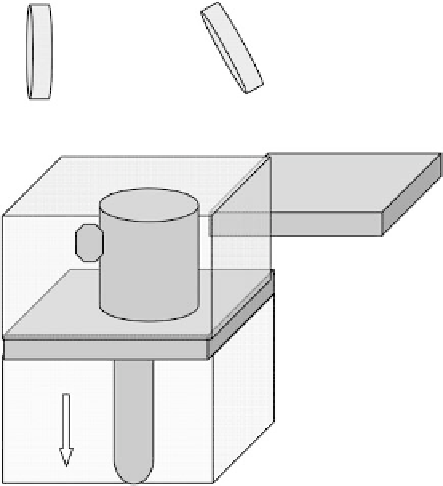Biomedical Engineering Reference
In-Depth Information
Mirror
Lens
Laser
3-D
scaffold
Nonphoto-polymerized
Piston
FIGURE 4.9
Scheme of photopolymerization using laser stereolithography.
structure with interconnected channels. Subsequently collagen dispersion was poured into the chan-
nels and solidifi ed through freeze-drying. Finally the phase 1 build material was dissolved away,
leaving a collagen containing 3-D scaffold with features of about 200 µm. A very similar method
was recently reported in which polypropylene fumarate was injected into a mold fabricated using
two-phase ink-jet printing. Phase 1 and phase 2 materials were wax (removed by heating and sol-
vent) and polystyrene (dissolved with acetone), respectively. The fi nal PPF scaffold has a resolution
of a few hundred microns and is mainly delimited by the precision of the ink-jet printer [21]. The
process is outlined in Figure 4.10.
The use of sacrifi cial molds adds to the complexity of the design, fabrication, and postprocess-
ing of scaffolds but eliminates the pseudo-3-D layered effect, which gives rise to the characteristic
steps that are observed in all other RP scaffolds. The fi nal structure is a homogeneous monolith
with channels, pores, and overhangs. However, this feature is obtained at the expense of extremely
long manufacture times; the RTM ratio is the lowest of all the RP methods described in this chapter.
Besides its complexity, a major disadvantage of this method is the inability to use different materials
in different areas and the limitations on choice of biomaterials, which have to be insoluble in the
solvent used to degrade the mold. Furthermore, owing to the multiple steps involved, the fi delity
of the scaffold is quite low. On the other hand, it is one of the few RP methods that can be used to
produce scaffolds composed of proteins such as collagen.
4.7.2 E
LECTROSPINNING
Although not strictly an RP method at present, electro or fi berspinning has the potential to become
an RP method by appropriate eletrostatic and mechanical control of the deposition plane.












